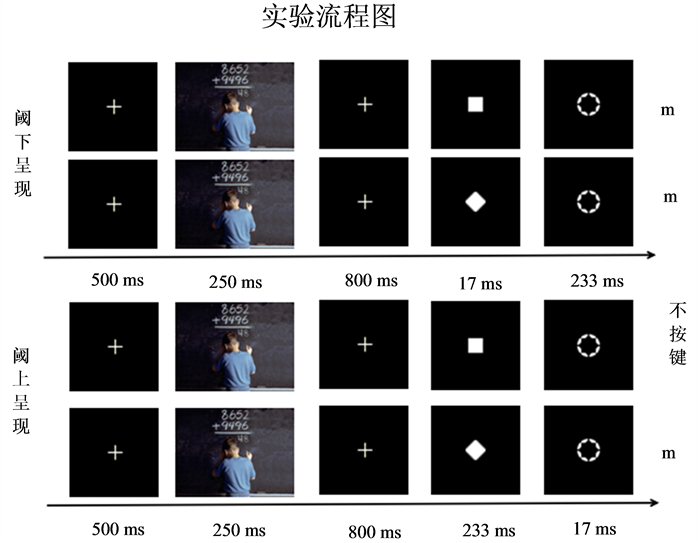1. 引言
反应抑制(inhibitory control)是一种取消已经发起的动作或者是取消已有计划的能力(van Gaal, Ridderinkhof, Fahrenfort et al., 2008),它是认知控制能力的一种体现,一般采用go/no-go范式或者stop-signal范式进行研究,在go/no-go任务中,go试次的数量会多于no-go试次,当出现go试次时,被试采取按键反应,形成一种反应倾向,而当no-go试次出现时,则需要抑制这种反应倾向。传统的研究认为认知控制需要意识的参与(Dehaene & Naccache, 2001; Hommel, 2007)。这是因为先前的研究发现认知控制的唤起和执行依赖于前额叶皮层的功能,而前额皮层又与意识经验有关,因而许多研究者自然而然地想到了“有意识认知控制”的概念,好像“无意识认知控制”是不可想象的(Hommel, 2007)。但是与传统的观点不同,最近对反应抑制的研究表明,反应抑制不仅可以由有意识信息引发,而且还可以由无意识信息引发(Jiang, Bailey, Chen et al., 2013; van Gaal & Lamme, 2012; van Gaal, Ridderinkhof, Fahrenfort et al., 2008; van Gaal, Ridderinkhof, Scholte et al., 2010),这些研究为无意识认知控制的存在提供了直接的实验证据。
情绪对反应抑制的影响一直以来都是研究的热点,有研究表明,与任务无关的情绪图片会消耗注意资源,从而阻碍反应抑制的表现(De Houwer & Tibboel, 2010; Hartikainen, Siiskonen & Ogawa, 2012; Lindstrom & Bohlin, 2012; Verbruggen & De Houwer, 2007);也有研究表明,情绪刺激能够促进反应抑制的表现(Pessoa, Padmala, Kenzer et al., 2012; Robinson, Krimsky & Grillon, 2013)。例如,在Pessoa(2012)等人的研究中,采用stop-signal范式,研究不同强度的威胁刺激对反应抑制的影响,结果发现,低强度的威胁刺激促进了反应抑制,而高强度的威胁刺激则阻碍了反应抑制。而在前人的研究中,所用到的情绪刺激,尤其是负性刺激是不同的,在Hartikainen(2012)等人的研究中,所采用的威胁刺激是蜘蛛,而在Verbruggen(2007)等人的研究中,则使用国际情绪图片库中的负性图片(如,肢体残缺图片)来诱发负性情绪。而这些情绪图片所诱发的情绪可能不仅仅是恐惧,或许还包含了厌恶(Libkuman, Otani, Kern et al., 2007)。
恐惧和厌恶同为高唤醒度的负性情绪,然而,它们之间还是有很多不同。第一,两种情绪的主观体验不同;第二,它们的生物学基础是不同的,厌恶主要与防止感染,而恐惧则与对危险的回避有关;第三,两者激活的脑区不同;第四,厌恶通过副交感神经调节,而恐惧则通过交感神经通道(Carretie, Ruiz-Padial, Lopez-Martin et al., 2011)。最近也有一些研究开始区分两者对感知觉、注意的影响,结果表明,两者确实产生不同的影响(Carretie, Ruiz-Padial, Lopez-Martin et al., 2011; Krusemark & Li, 2011; Nicol, Perrotta, Caliciuri et al., 2013; Susskind, Lee, Cusi et al., 2008; van Hooff, Devue, Vieweg et al., 2013; Vermeulen, Godefroid & Mermillod, 2009; Wheaton, Holman, Rabinak et al., 2013)。简单来说,面对恐惧时,个体很容易采取应对,而当面对厌恶时,需要消耗更多的注意资源来对厌恶刺激进行危险性评估,因而需要花费更多的时间。
阈下反应抑制对于我们日常的生活十分重要,我们的许多动作都是在无意识的状态下完成的。前人对情绪影响反应抑制的影响主要集中在阈上,而对阈下诱发反应抑制的影响还没有研究,同时,根据达尔文的进化论,不同的情绪必定有其不同的适应功能,而前人所用的负性刺激所诱发的情绪(如恐惧)可能并不单单是一种情绪的作用。对不同情绪的作用进行区分,可以使我们更准确的了解情绪对执行控制的影响,并且在临床研究上,也可以对某些情绪障碍提出一些有益的启发。因此,在本研究中,我们通过区分恐惧和厌恶情绪,采用van Gaal(2010)等人的实验范式来操作阈下反应抑制,考察情绪对阈下诱发反应抑制的影响。我们预测:一,相对于中性刺激,负性刺激会阻碍阈下诱发的反应抑制;二,恐惧和厌恶对阈下诱发的反应抑制会有不同的影响。
2. 实验一
2.1. 被试
随机选取某大学学生22名女性大学生作为被试,年龄在18~24岁之间(M年龄 = 21岁,SD = 1.37),所有被试身体健康,均为右利手,裸眼视力或矫正视力正常,无色盲等眼疾。所有被试均未参加过类似的实验,并均为自愿参加实验,实验之后给予一定报酬。
2.2. 刺激和材料
情绪图片为国际情绪图片库中选取120张图片,其中中性图片和负性图片各60张。实验中的所有刺激均在相同规格的20英寸的戴尔显示器上,显示器的刷新率为60 Hz。被试坐在离屏幕大约70 cm的位置上,对刺激进行按键反应。刺激呈现和数据收集均使用E-prime软件完成。
2.3. 实验设计
实验一是2(情绪:中性、负性)*2(阈下go/no-go)的实验设计,因变量为反应时和正确率。前人研究表明,女性对情绪图片的情绪反应更强烈(Schienle, Schafer, Stark et al., 2005),为了排除性别因素的影响,本研究中全部选取女性被试参加实验。
2.4. 实验程序
实验采用van Gaal(2010)所使用的go/no-go实验范式,具体流程见图1。在实验中,首先出现一个注视点,呈现500 ms,之后出现一张情绪图片,呈现250 ms,然后是一个800 ms的注视点,之后是一个正方形或菱形,呈现233 ms(或17 ms),最后是一个偏对比掩蔽的圆环17 ms(或233 ms)。实验前告诉被试,如果只能看到一个白色的圆环出现,他们需要又快又准地按m键;但是当一个白色正方形在白色圆环出现之前就出现时,被试不要按键;如果一个白色菱形在白色圆环之前就出现时,被试仍然需要按m键。在实验中,no-go信号(正方形或菱形)在被试间进行平衡。正式实验包括两个block,每个包含120个试次,情绪图片和试次都完全随机呈现。正式实验前,首先让被试做40个练习试次,练习试次中的图片与正式实验中的不同。
为了确保在正式实验中阈下操作go或者no-go信号(即呈现17 ms时)的成功,在完成正式实验之后,每个被试需要完成一个辨别测验。实验中,首先出现一个注视点,呈现500 ms,之后出现一个正方形或菱形,呈现17 ms,最后是一个偏对比掩蔽的圆环233 ms。要求被试判断所出现的图形是正方形还是菱

Figure 1. Experiment design
图1. 实验流程图
形。迫选测验共包括90个试次,随机呈现。
2.5. 结果与分析
因为本研究目的是考察情绪对阈下反应抑制的影响,所以我们重点分析阈下试次的数据(对阈上go试次正确反应反应时以及阈上go/no-go试次正确率分析,表明情绪间差异不显著,pall > .1),下同。
在正确反应中,剔除反应时小于100 ms和大于1200 ms的试次,不同情绪时阈下go/no-go条件的反应时见表1。
对阈下反应时做2(中性、负性)*2(go/no-go)的重复测量方差分析发现,两者交互作用显著,F (1,21) = 6.57,p = .018;go/no-go的主效应显著,F (1,21) = 5.52,p = .029,no-go的反应时比go的反应时要长。简单效应分析表明,当情绪图片是中性时,出现了阈下的反应抑制,no-go试次的反应时比go试次的更长,p = .004,而当情绪图片是负性时,go和no-go的反应时没有显著差异,p = .45;且在go试次上,两种情绪图片在反应时上没有差异,p = .63,而在no-go试次上,负性图片的反应时要比中性图片的反应时要快,p = .020。
在阈下反应正确率上,2(中性、负性)*2(go/no-go)的重复测量方差分析发现,交互作用不显著,主效应都不显著(p > .13)。
根据信号检测论对事后辨别测验的结果分析表明,在阈下呈现时,被试不能知觉到刺激的形状(d’ = 0.15, t(21) = 1.55, p > .13),说明阈下操作成功。
实验一的结果验证了第一个预期,与中性相比,负性情绪确实会阻碍阈下反应抑制。但实验一中所用的负性情绪图片(如肢体残缺图片)所诱发的情绪既可能是恐惧,也可能包含了厌恶(Libkuman, Otani, Kern et al., 2007),而前面提到很多研究都表明,恐惧和厌恶两种负性情绪对知觉注意的影响可能是不同的。所以,在实验二中,我们进一步将恐惧和厌恶区分,来考察两者对阈下反应抑制的影响。
3. 实验二
3.1. 被试
重新随机选取某大学学生23名女性大学生作为被试,年龄在18~24岁之间(M年龄 = 20.41,SD = 1.18),所有被试身体健康,均为右利手,裸眼视力或矫正视力正常,无色盲等眼疾。
3.2. 实验材料
采取与van Hooff(2013)等人相同的图片选取方法,从国际情绪图片库中和网络上选取90张图片,其中中性、恐惧和厌恶图片各30张。在选取恐惧和厌恶图片时,尽量避免可能产生两种复合情绪的图片。最终选取的恐惧图片内容包括蛇、枪支等,厌恶图片内容包括粪便、呕吐物等。
正式实验前,请23名被试对图片的效价、唤醒度、恐惧和厌恶程度进行评定,结果见表2。
为了最大程度上考察恐惧和厌恶的区别,本研究匹配了图片的效价和唤醒度,最终选取60张图片,其中中性、恐惧和厌恶各20张,恐惧和厌恶图片的效价和唤醒度没有显著差异(p > .10),恐惧图片的恐惧程度要高于中性和厌恶图片(p < .001),厌恶图片的厌恶程度要高于中性和恐惧图片(p < .001)。
3.3. 实验程序
正式实验程序和事后测验程序与实验一完全相同,正式实验包括5个block,每个block包含120个试次,三种情绪图片随机呈现。
3.4. 结果与分析
在正确反应中,剔除反应时小于100 ms和大于1200 ms的试次,不同情绪时阈下go/no-go条件的反应时见表3。
对阈下反应时做3(中性、恐惧、厌恶)*2(go/no-go)的重复测量方差分析发现,两者交互作用不显著,F (2,21) = .678,p = .519;go/no-go的主效应显著,F (2,21) = 9.504,p = .009,no-go的反应时比go的反

Table 1. Subconscious go/no-go RTs under different emotion
表1. 不同情绪时阈下go/no-go反应时

Table 2. Ratings of emotional pictures
表2. 情绪图片评定结果
注:图片评定为1~9级评定,效价数值越低表明负性越强;唤醒度数值越高表明唤醒越高;恐惧数值越低表明恐惧程度越高;厌恶数值越低表明厌恶程度越高。

Table 3. Subconscious go/no-go RTs under different emotion
表3. 不同情绪时阈下go/no-go反应时
应时要长。进一步分析表明,当情绪图片是中性时,出现了阈下的反应抑制,no-go试次的反应时比go试次的更长,p = .06;当情绪图片是恐惧时,no-go试次的反应时比go试次的更长,p = .047;而当情绪图片是厌恶时,go和no-go的反应时没有显著差异,p = .99。
在阈下反应正确率上,3(中性、恐惧、厌恶)*2(go/no-go)的重复测量方差分析发现,交互作用不显著,主效应都不显著。
对事后辨别测验的结果分析表明,在阈下呈现时,被试的反应正确率和0.5的机遇水平差异不显著(t (22) = −1.72,p = .10),说明被试不能知觉到刺激的形状,阈下操作成功。
4. 讨论
采用van Gaal(2010)等人创立的范式,我们考察了负性情绪对阈下反应抑制的影响,并进一步探讨恐惧和厌恶这两种负性情绪对阈下反应抑制的影响是否有差别。实验结果表明,负性情绪阻碍了反应抑制,这与前人对阈上反应抑制的研究结果一致。对情绪图片阻碍反应抑制的机制,一种解释认为人的认知资源有限,情绪图片会消耗认知资源从而对后续的认知加工造成影响(Fox, Russo, Bowles et al., 2001);另一种解释认为情绪性刺激会使所有的活动都产生短暂的中断,即产生一种freezing的作用(Algom, Chajut & Lev, 2004)。而近来的研究倾向于支持第一种解释。在De Houwer(2010)等人的研究中,首先出现一张情绪图片,然后做go/no-go反应,结果发现情绪图片对go试次没有影响,而高唤醒情绪图片阻碍了在no-go试次上的反应,他们认为这是因为情绪图片消耗了认知资源,因而对后面的反应抑制能力产生了阻碍作用。在Hartikainen(2012)等人的研究中,用蜘蛛来诱发恐惧情绪,在go/no-go任务中,同样发现在go试次上,情绪图片和中性图片差异不显著,而在no-go试次上,情绪图片产生了阻碍作用,他们也认为由于情绪图片消耗了认知资源从而减弱了其他的执行控制功能。在本研究中,实验一的结果与认知资源理论的预期一致,负性图片阻碍了阈下反应抑制。
本研究的第二个目的是考察恐惧和厌恶是否对反应抑制有不同的影响,在前人的研究中,对这两种负性情绪的区分大多在知觉注意功能上,在van Hooff(2013)等人的研究中,首先呈现一张情绪图片,然后在图片的上下左右四个位置之一随机出现字母Z或N,被试的任务是判断辨别字母。结果发现,在图片和字母出现的间隔为200 ms时,当图片是厌恶图片时,做出反应的时间要比恐惧和中性图片更长。他们认为这是由于恐惧图片所诱发的恐惧情绪会很快的让被试产生警觉,而厌恶图片所包含的意义则相对模糊一些,因而需要个体花费更多的时间和资源来对图片的危险性进行评估,从而使反应的速度变慢。同样的,在Krusemark(2011)等的研究中,采用视觉搜索任务,考察了恐惧和厌恶对注意的影响,结果发现,恐惧使搜索的反应变快,而厌恶则使搜索的反应更慢。而在本研究中,实验二表明,厌恶和恐惧对反应抑制的影响或许是不同的。在恐惧和中性条件时,都出现了阈下反应抑制,而在厌恶条件下,并没有出现反应抑制。但在go和no-go试次上,恐惧和厌恶情绪都没有差异。这可能是由两个原因造成的,首先,前人对两者区分的研究只涉及知觉注意层面,而对执行控制这一高级的认知功能,作用可能并不是很明显;其次,前人研究的范式中,在一个试次中,情绪图片会一直呈现,直到按键结束,而在本研究中,情绪图片只呈现250 ms,且之后还会有800 ms的间隔,然后才是按键任务,可能正是由于情绪图片消失到按键任务之间的时间间隔过长,进一步减弱了两者之间的区别。也有研究表明,时间间隔对于任务的影响是不容忽视的。在Bocanegra(2009)等人的研究中,当情绪刺激和任务的时间间隔较短时,会阻碍任务表现,而当时间间隔较长时,则会促进任务表现,他们认为这是由于时间间隔较长会减弱情绪刺激和任务之间对认知资源的竞争。尽管在go和no-go试次上两者没有显著差异,但在恐惧条件时出现了阈下反应抑制,而厌恶条件时并没有出现,这表明,两者对反应抑制的影响或许还是有差异的,这对于我们研究焦虑等情绪障碍提供了一个新的方向,比如之前通常用蜘蛛来诱发恐惧情绪,那诱发出的情绪作用到底是恐惧还是厌恶,值得我们进行重新的思考。
5. 展望
前人对情绪影响反应抑制的研究多集中在阈上,且所用的负性情绪一般都只对效价和唤醒度进行区分,而本研究进一步考察了负性情绪,特别是恐惧和厌恶情绪对阈下反应抑制的影响,结果支持了认知资源理论,情绪性刺激消耗了认知资源,从而对阈下反应抑制产生了阻碍作用,而恐惧和厌恶情绪对阈下反应抑制的影响可能是不同的,下一步可以采用其他手段继续考察恐惧和厌恶情绪对阈下反应抑制的不同影响。
6. 结论
负性情绪阻碍了阈下反应抑制,恐惧和厌恶情绪对阈下反应抑制的影响可能是不同的。

NOTES
*通讯作者。